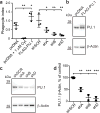A common haplotype lowers PU.1 expression in myeloid cells and delays onset of Alzheimer's disease
- PMID: 28628103
- PMCID: PMC5759334
- DOI: 10.1038/nn.4587
A common haplotype lowers PU.1 expression in myeloid cells and delays onset of Alzheimer's disease
Abstract
A genome-wide survival analysis of 14,406 Alzheimer's disease (AD) cases and 25,849 controls identified eight previously reported AD risk loci and 14 novel loci associated with age at onset. Linkage disequilibrium score regression of 220 cell types implicated the regulation of myeloid gene expression in AD risk. The minor allele of rs1057233 (G), within the previously reported CELF1 AD risk locus, showed association with delayed AD onset and lower expression of SPI1 in monocytes and macrophages. SPI1 encodes PU.1, a transcription factor critical for myeloid cell development and function. AD heritability was enriched within the PU.1 cistrome, implicating a myeloid PU.1 target gene network in AD. Finally, experimentally altered PU.1 levels affected the expression of mouse orthologs of many AD risk genes and the phagocytic activity of mouse microglial cells. Our results suggest that lower SPI1 expression reduces AD risk by regulating myeloid gene expression and cell function.
Conflict of interest statement
I.B. is an employee of Regeneron Pharmaceuticals, Inc. A.M.G. is on the scientific advisory board for Denali Therapeutics and has served as a consultant for AbbVie and Cognition Therapeutics.
Figures




References
MeSH terms
Substances
Grants and funding
- U01 AG024904/AG/NIA NIH HHS/United States
- RF1 AG054011/AG/NIA NIH HHS/United States
- P01 AG026276/AG/NIA NIH HHS/United States
- U19 AG024904/AG/NIA NIH HHS/United States
- MR/L023784/1/MRC_/Medical Research Council/United Kingdom
- U01 AG049508/AG/NIA NIH HHS/United States
- MC_PC_17112/MRC_/Medical Research Council/United Kingdom
- R25 DA027995/DA/NIDA NIH HHS/United States
- R01 AG044546/AG/NIA NIH HHS/United States
- U24 AG021886/AG/NIA NIH HHS/United States
- Z99 AG999999/ImNIH/Intramural NIH HHS/United States
- U01 AG052411/AG/NIA NIH HHS/United States
- U01 AG032984/AG/NIA NIH HHS/United States
- RF1 AG053303/AG/NIA NIH HHS/United States
- G0300429/MRC_/Medical Research Council/United Kingdom
- P01 AG003991/AG/NIA NIH HHS/United States
- P50 AG005681/AG/NIA NIH HHS/United States
- MR/P005748/1/MRC_/Medical Research Council/United Kingdom
- 201488/Z/16/Z/WT_/Wellcome Trust/United Kingdom
- R01 AG033193/AG/NIA NIH HHS/United States
- P50 AG005138/AG/NIA NIH HHS/United States
- RF1 AG044546/AG/NIA NIH HHS/United States
- MR/L023784/2/MRC_/Medical Research Council/United Kingdom
- MR/L010305/1/MRC_/Medical Research Council/United Kingdom
- R01 AG035083/AG/NIA NIH HHS/United States
- U01 AG049505/AG/NIA NIH HHS/United States
LinkOut - more resources
Full Text Sources
Other Literature Sources
Medical
Molecular Biology Databases
Research Materials

